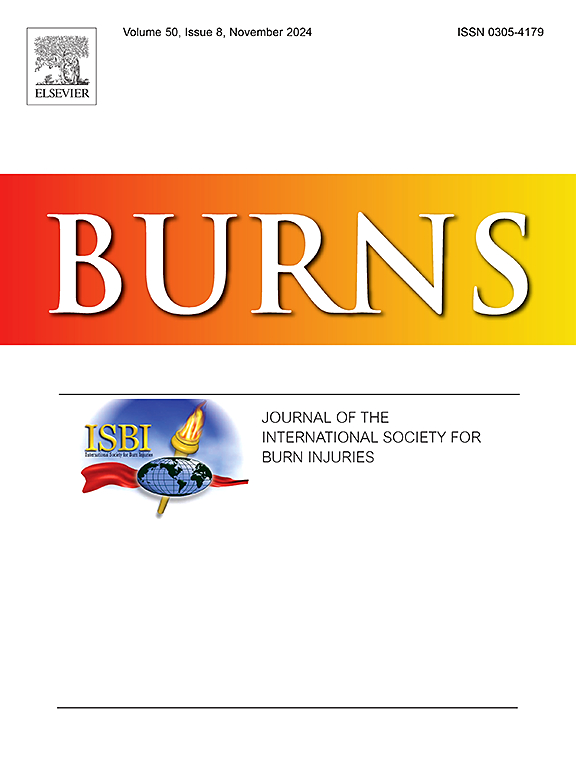严重烧伤后24小时内较低的液体复苏量与存活和出院天数独立相关:一项回顾性队列研究。
IF 2.9
3区 医学
Q2 CRITICAL CARE MEDICINE
引用次数: 0
摘要
背景:严重烧伤的最佳液体复苏量尚不清楚。临床试验受到严重烧伤的罕见性和相对较低的死亡率的挑战,导致使用连续的替代结果来增加统计效力。尽管烧伤患者比一般危重患者住院时间更长,但90天的存活和出院天数(DAOH)已被证实是危重患者长期死亡率和功能结局的标志。我们的目的是描述损伤后第一个24 h的液体体积与第90天和第180天(分别为DAOH90和DAOH180)的DAOH之间的关系。方法:回顾性队列研究所有124例患者入院> 20% %全身表面积(TBSA)烧伤5年期间澳大利亚烧伤转诊中心ICU。结果:前24 h中位液量为4.8 (IQR 3.3 ~ 6.3) mL/kg/TBSA%。采用线性分位数回归模型,在调整年龄、TBSA%、损伤严重程度和吸入性损伤后,在前24 h内,液体每增加mL/kg/TBSA%,中位数下降3.71 DAOH90(95 % CI 1.62-5.12, p = 0.002)和4.41 DAOH180(95 % CI 2.21-7.22, p = 0.035)。对相同协变量进行调整后的受限三次样条模型显示,损伤后24小时 h内的体液体积与DAOH90和DAOH180均呈负线性关系(DAOH90的p = 0.859,DAOH180的p = 0.979)。结论:调整已知混杂因素后,前24小时液体量 h与DAOH90和DAOH180呈负线性关系。两者都可以作为未来严重烧伤复苏临床试验的连续的、以患者为中心的结果。本文章由计算机程序翻译,如有差异,请以英文原文为准。
Lower fluid resuscitation volumes in the first 24 hours following a severe burn injury are independently associated with greater days alive and out of hospital: A retrospective cohort study
Background
The optimal fluid resuscitation volume for severe burns is unknown. Clinical trials are challenged by the rarity of severe burns and the relatively low mortality rate resulting in the use of continuous surrogate outcomes to increase statistical power. Days alive and out of hospital (DAOH) at day 90 has been validated in the critically ill as a marker of long-term mortality and functional outcomes, although burns patients experience longer hospital admissions than the general critically ill population. We aimed to describe the association between fluid volume in the first 24 h post injury and DAOH at day 90 and day 180 (DAOH90 and DAOH180 respectively).
Methods
Retrospective cohort study of all 124 patients admitted with > 20 % total body surface area (TBSA) burns to a major Australian burns referral centre ICU over a 5-year period.
Results
Median fluid volume in first 24 h was 4.8 (IQR 3.3–6.3) mL/kg/TBSA%. Using linear quantile regression modelling, after adjusting for age, TBSA%, injury severity, and inhalational injury, for every mL/kg/TBSA% increase in fluid in the first 24 h, there was a median decrease of 3.71 DAOH90 (95 % CI 1.62–5.12, p = 0.002) and 4.41 DAOH180 (95 % CI 2.21–7.22, p = 0.035). Restricted cubic spline modelling adjusted for the same covariates demonstrated a negative linear relationship between fluid volume in the first 24 h post injury and both DAOH90 and DAOH180 (p = 0.859 for DAOH90 and p = 0.979 for DAOH180).
Conclusions
Adjusting for known confounders, there was a negative linear relationship between fluid volumes in the first 24 h and DAOH90 and DAOH180. Either could be used as a continuous, patient-centred outcome for future clinical trials of severe burn resuscitation.
求助全文
通过发布文献求助,成功后即可免费获取论文全文。
去求助
来源期刊

Burns
医学-皮肤病学
CiteScore
4.50
自引率
18.50%
发文量
304
审稿时长
72 days
期刊介绍:
Burns aims to foster the exchange of information among all engaged in preventing and treating the effects of burns. The journal focuses on clinical, scientific and social aspects of these injuries and covers the prevention of the injury, the epidemiology of such injuries and all aspects of treatment including development of new techniques and technologies and verification of existing ones. Regular features include clinical and scientific papers, state of the art reviews and descriptions of burn-care in practice.
Topics covered by Burns include: the effects of smoke on man and animals, their tissues and cells; the responses to and treatment of patients and animals with chemical injuries to the skin; the biological and clinical effects of cold injuries; surgical techniques which are, or may be relevant to the treatment of burned patients during the acute or reconstructive phase following injury; well controlled laboratory studies of the effectiveness of anti-microbial agents on infection and new materials on scarring and healing; inflammatory responses to injury, effectiveness of related agents and other compounds used to modify the physiological and cellular responses to the injury; experimental studies of burns and the outcome of burn wound healing; regenerative medicine concerning the skin.
 求助内容:
求助内容: 应助结果提醒方式:
应助结果提醒方式:


